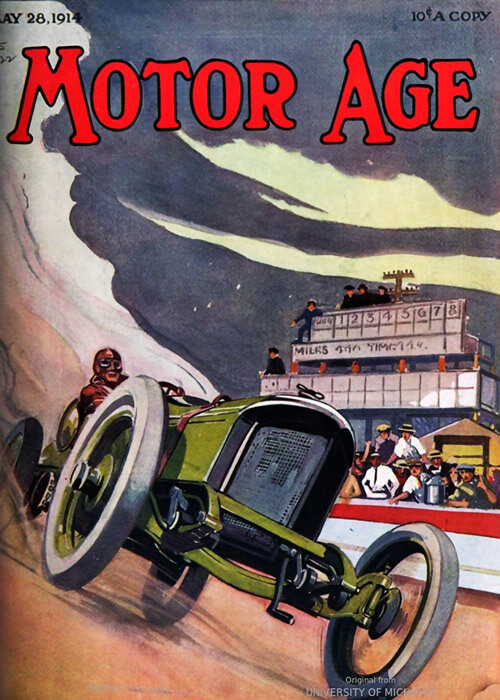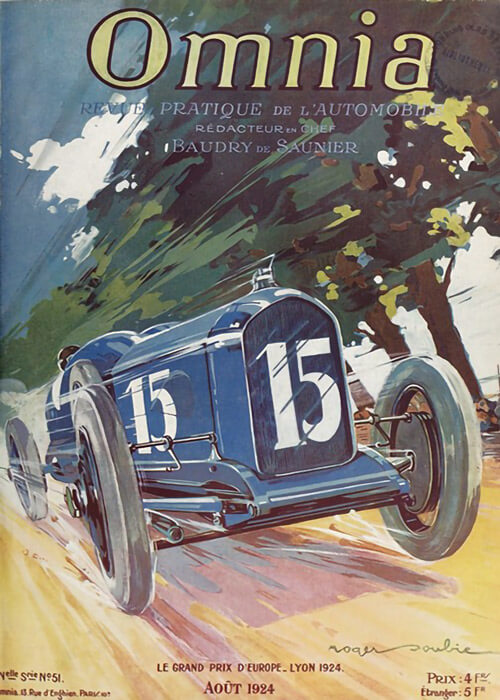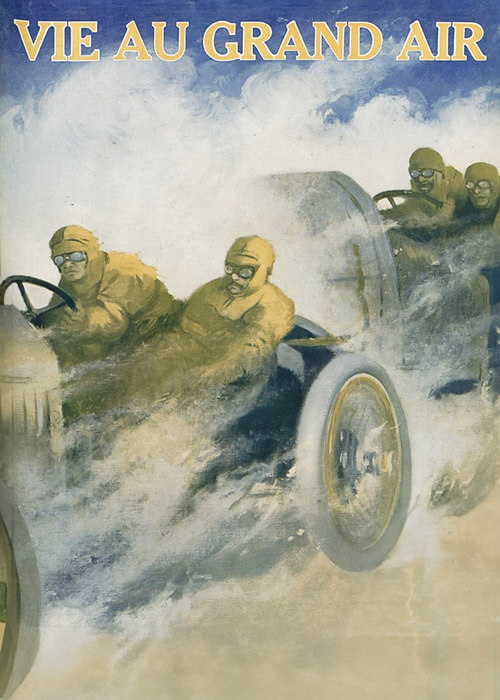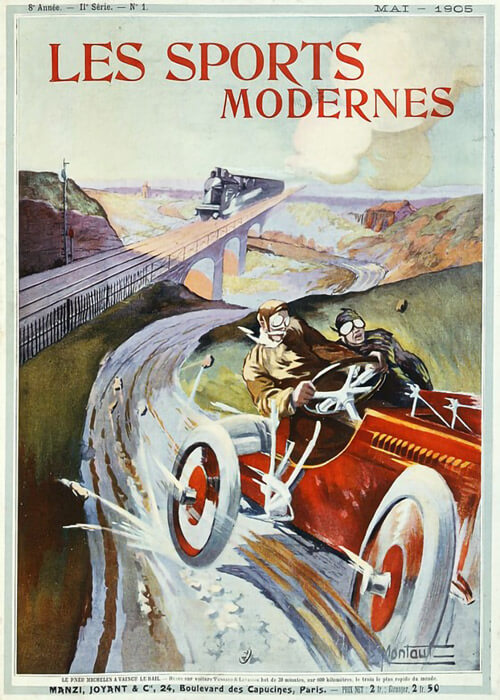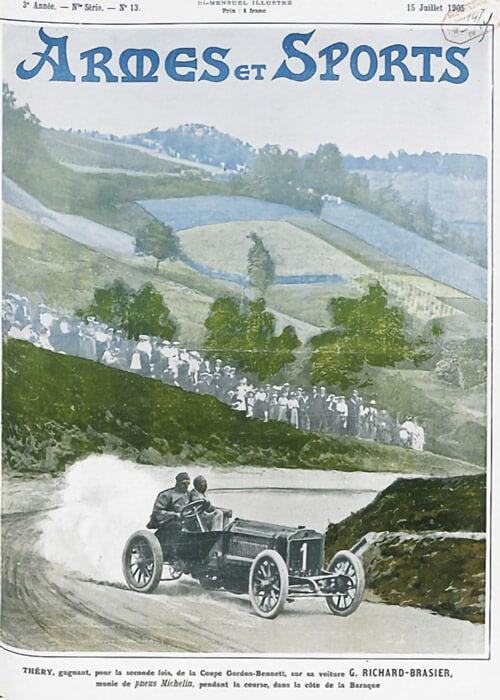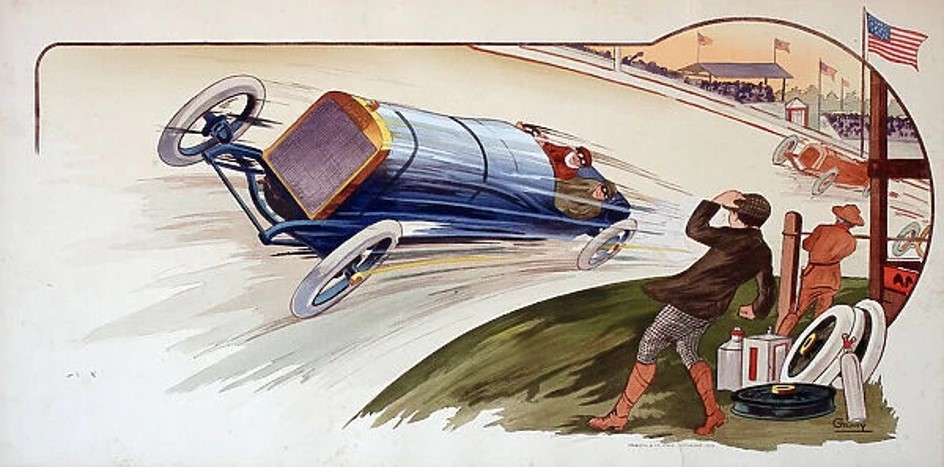Shortly before the 500-mile race, the magazine Automobile Topics published an introduction article. Here, prize money is discussed, as well as the „conditions of the race“. The best-known drivers are presented, the starting system is explained, and spectator specifics such as accomodations and travel means are highlighted.

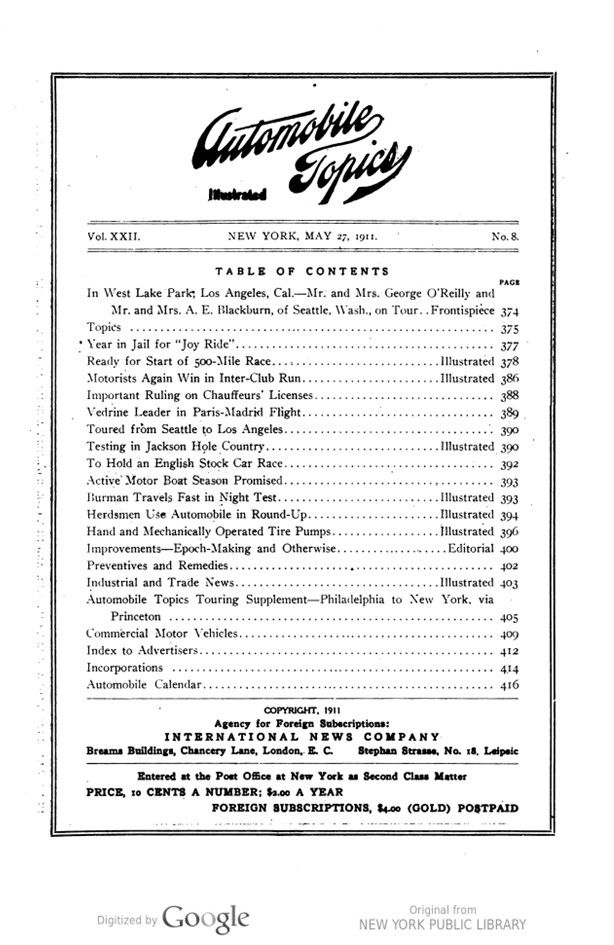
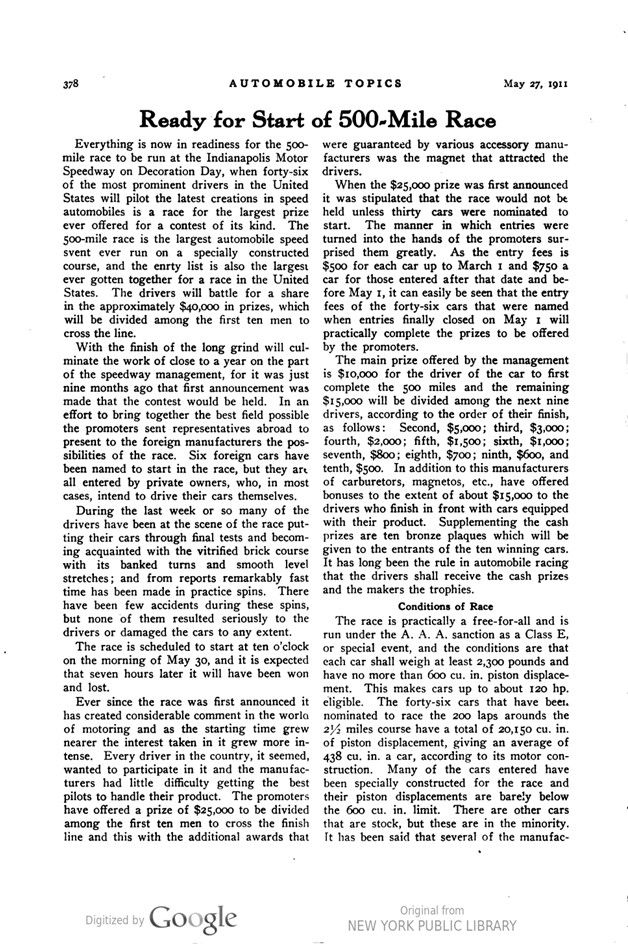
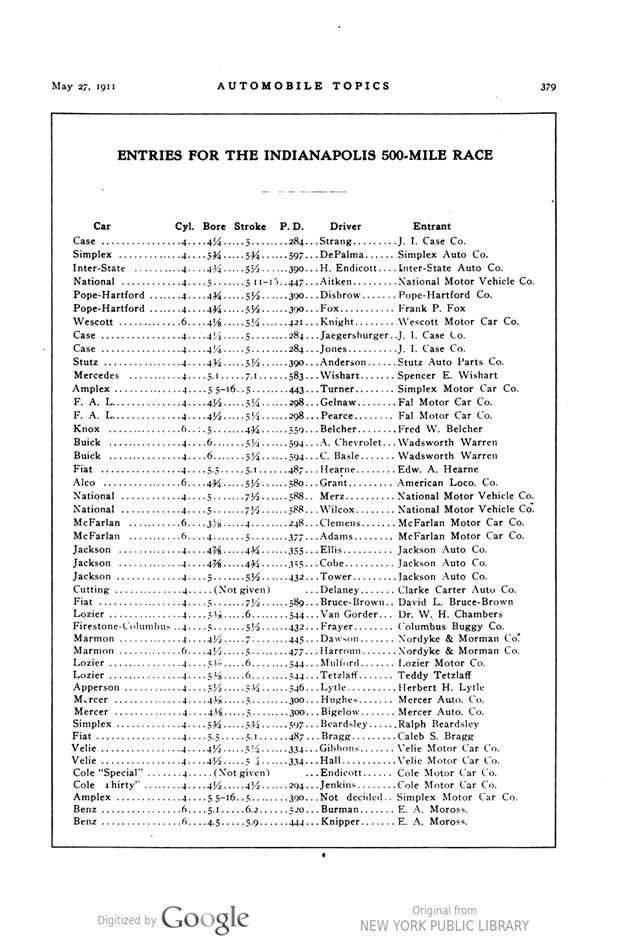
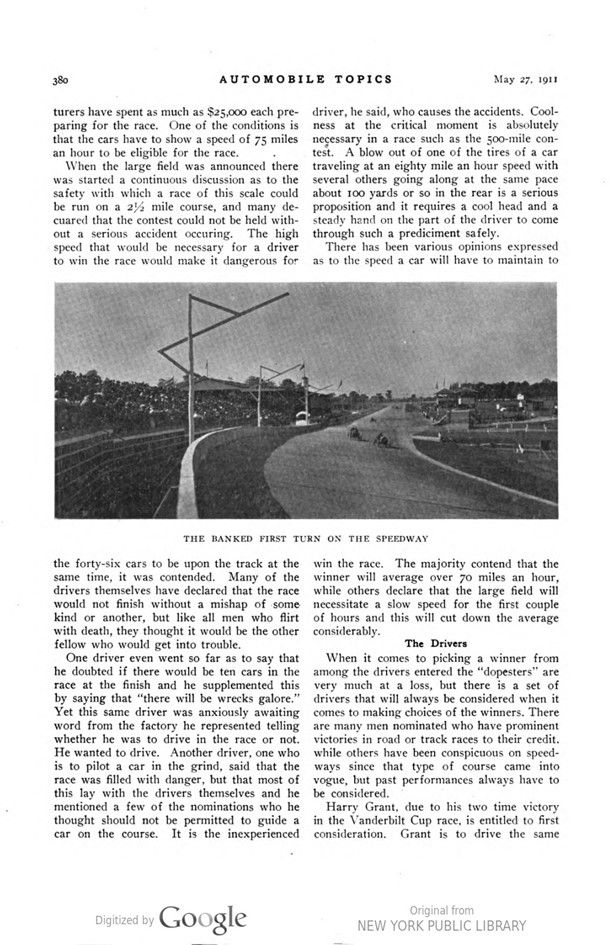
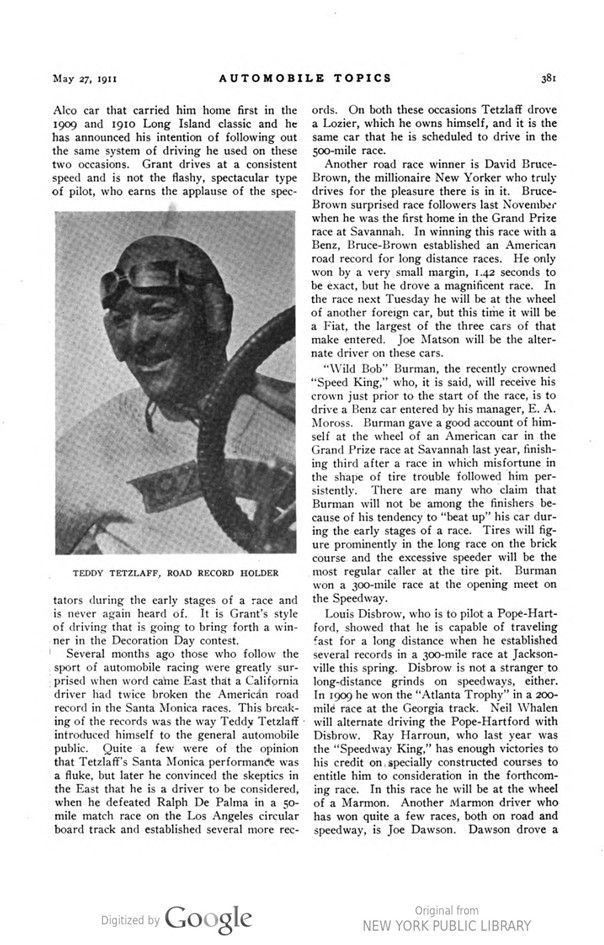


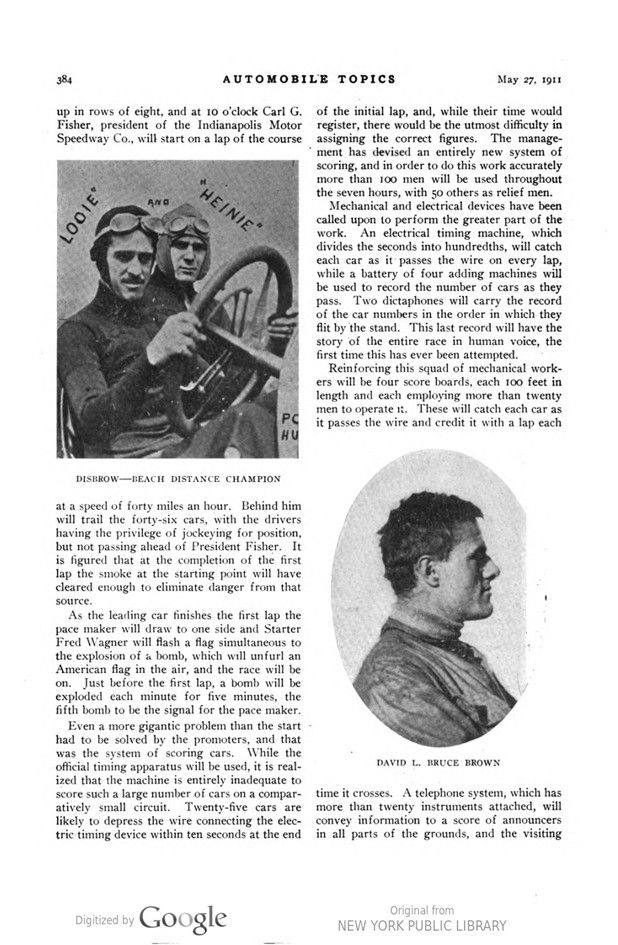

Text and jpegs by courtesy of hathitrust.org www.hathitrust.org, compiled by motorracinghistory.com
AUTOMOBILE TOPICS. Vol. XXII, No. 8, May 27, 1911
Ready for Start of 500-Mile Race
Everything is now in readiness for the 500-mile race to be run at the Indianapolis Motor Speedway on Decoration Day, when forty-six of the most prominent drivers in the United States will pilot the latest creations in speed automobiles is a race for the largest prize ever offered for a contest of its kind. The 500-mile race is the largest automobile speed event ever run on a specially constructed course, and the entry list is also the largest ever gotten together for a race in the United States. The drivers will battle for a share in the approximately $40,000 in prizes, which will be divided among the first ten men to cross the line.
With the finish of the long grind will culminate the work of close to a year on the part of the speedway management, for it was just nine months ago that first announcement was made that the contest would be held. In an effort to bring together the best field possible the promoters sent representatives abroad to present to the foreign manufacturers the possibilities of the race. Six foreign cars have been named to start in the race, but they are all entered by private owners, who, in most cases, intend to drive their cars themselves.
During the last week or so many of the drivers have been at the scene of the race putting their cars through final tests and becoming acquainted with the vitrified brick course with its banked turns and smooth level stretches; and from reports remarkably fast time has been made in practice spins. There have been few accidents during these spins, but none of them resulted seriously to the drivers or damaged the cars to any extent.
The race is scheduled to start at ten o’clock on the morning of May 30, and it is expected that seven hours later it will have been won and lost.
Ever since the race was first announced it has created considerable comment in the world of motoring and as the starting time grew nearer the interest taken in it grew more intense. Every driver in the country, it seemed, wanted to participate in it and the manufacturers had little difficulty getting the best pilots to handle their product. The promoters have offered a prize of $25,000 to be divided among the first ten men to cross the finish line and this with the additional awards that were guaranteed by various accessory manufacturers was the magnet that attracted the drivers.
When the $25,000 prize was first announced it was stipulated that the race would not be held unless thirty cars were nominated to start. The manner in which entries were turned into the hands of the promoters surprised them greatly. As the entry fees is $500 for each car up to March 1 and $750 a car for those entered after that date and before May 1, it can easily be seen that the entry fees of the forty-six cars that were named when entries finally closed on May 1 will practically complete the prizes to be offered by the promoters.
The main prize offered by the management is $10,000 for the driver of the car to first complete the 500 miles and the remaining $15,000 will be divided among the next nine drivers, according to the order of their finish, as follows: Second, $5,000; third, $3,000; fourth, $2,000; fifth, $1,500; sixth, $1,000; seventh, $800; eighth, $700; ninth, $600, and tenth, $500. In addition to this manufacturers of carburetors, magnetos, etc., have offered bonuses to the extent of about $15,000 to the drivers who finish in front with cars equipped with their product. Supplementing the cash prizes are ten bronze plaques which will be given to the entrants of the ten winning cars. It has long been the rule in automobile racing that the drivers shall receive the cash prizes and the makers the trophies.
Conditions of Race
The race is practically a free-for-all and is run under the A. A. A. sanction as a Class E, or special event, and the conditions are that each car shall weigh at least 2,300 pounds and have no more than 600 cu. in. piston displacement. This makes cars up to about 120 hp. eligible. The forty-six cars that have been nominated to race the 200 laps arounds the 25$ miles course have a total of 20,150 cu. in. of piston displacement, giving an average of 438 cu. in. a car, according to its motor construction. Many of the cars entered have been specially constructed for the race and their piston displacements are barely below the 600 cu. in. limit. There are other cars that are stock, but these are in the minority. It has been said that several of the manufacturers have spent as much as $2 5,000 each preparing for the race. One of the conditions is that the cars have to show a speed of 75 miles an hour to be eligible for the race.
When the large field was announced there was started a continuous discussion as to the safety with which a race of this scale could be run on a 2½ mile course, and many declared that the contest could not be held without a serious accident occurring. The high speed that would be necessary for a driver to win the race would make it dangerous for the forty—six cars to be upon the track at the same time, it was contended. Many of the drivers themselves have declared that the race would not finish without a mishap of some kind or another, but like all men who flirt with death, they thought it would be the other fellow who would get into trouble.
One driver even went so far as to say that he doubted if there would be ten cars in the race at the finish and he supplemented this by saying that “there will be wrecks galore.” Yet this same driver was anxiously awaiting word from the factory he represented telling whether he was to drive in the race or not. He wanted to drive. Another driver, one who is to pilot a car in the grind, said that the race was filled with danger, but that most of this lay with the drivers themselves and he mentioned a few of the nominations who he thought should not be permitted to guide a car on the course. It is the inexperienced driver, he said, who causes the accidents. Coolness at the critical moment is absolutely necessary in a race such as the 500-mile contest. A blow out of one of the tires of a car traveling at an eighty mile an hour speed with several others going along at the same pace about 100 yards or so in the rear is a serious proposition and it requires a cool head and a steady hand on the part of the driver to come through such a prediciment safely.
There has been various opinions expressed as to the speed a car will have to maintain to win the race. The majority contend that the winner will average over 70 miles an hour, while others declare that the large field will necessitate a slow speed for the first couple of hours and this will cut down the average considerably.
The Drivers
When it comes to picking a winner from among the drivers entered the “dopesters” are very much at a loss, but there is a set of drivers that will always be considered when it comes to making choices of the winners. There are many men nominated who have prominent victories in road or track races to their credit, while others have been conspicuous on speedways since that type of course came into vogue, but past performances always have to be considered.
Harry Grant, due to his two time victory in the Vanderbilt Cup race, is entitled to first consideration. Grant is to drive the same Alco car that carried him home first in the 1909 and I910 Long Island classic and he has announced his intention of following out the same system of driving he used on these two occasions. Grant drives at a consistent speed and is not the flashy, spectacular type of pilot, who earns the applause of the spectators during the early stages of a race and is never again heard of. It is Grant’s style of driving that is going to bring forth a winner in the Decoration Day contest.
Several months ago, those who follow the sport of automobile racing were greatly surprised when word came East that a California driver had twice broken the American road record in the Santa Monica races. This breaking of the records was the way Teddy Tetzlaff introduced himself to the general automobile public. Quite a few were of the opinion that Tetzlaff’s Santa Monica performance was a fluke, but later he convinced the skeptics in the East that he is a driver to be considered, when he defeated Ralph De Palma in a 50-mile match race on the Los Angeles circular board track and established several more records. On both these occasions Tetzlaff drove a Lozier, which he owns himself, and it is the same car that he is scheduled to drive in the 500-mile race.
Another road race winner is David Bruce-Brown, the millionaire New Yorker who truly drives for the pleasure there is in it. Bruce-Brown surprised race followers last November when he was the first home in the Grand Prize race at Savannah. In winning this race with a Benz, Bruce-Brown established an American road record for long distance races. He only won by a very small margin, 1.42 seconds to be exact, but he drove a magnificent race. In the race next Tuesday, he will be at the wheel of another foreign car, but this time it will be a Fiat, the largest of the three cars of that make entered. Joe Matson will be the alternate driver on these cars.
“Wild Bob“ Burman, the recently crowned “Speed King,” who, it is said, will receive his crown just prior to the start of the race, is to drive a Benz car entered by his manager, E. A. Moross. Burman gave a good account of himself at the wheel of an American car in the Grand Prize race at Savannah last year, finishing third after a race in which misfortune in the shape of tire trouble followed him persistently. There are many who claim that Burman will not be among the finishers because of his tendency to “beat up” his car during the early stages of a race. Tires will figure prominently in the long race on the brick course and the excessive speeder will be the most regular caller at the tire pit. Burman won a 300—mile race at the opening meet on the Speedway.
Louis Disbrow, who is to pilot a Pope—Hartford, showed that he is capable of traveling fast for a long distance when he established several records in a 300-mile race at Jacksonville this spring. Disbrow is not a stranger to long-distance grinds on speedways, either. In I909 he won the “Atlanta Trophy” in a 200-mile race at the Georgia track. Neil Whalen will alternate driving the Pope-Hartford with Disbrow. Ray Harroun, who last year was the “Speedway King,” has enough victories to his credit on specially constructed courses to entitle him to consideration in the forthcoming race. In this race he will be at the wheel of a Marmon. Another Marmon driver who has won quite a few races, both on road and speedway, is Joe Dawson. Dawson drove a sensational race in the last Vanderbilt Cup contest, only to be beaten out at the finish by less than a minute. The National team of Aitken, Merz and Wilcox is one that will be conspicuous in the race. They are all familiar with the track, their headquarters being in Indianapolis, and one of the “blue streaks” is more than likely to be among the leaders. Len Zengle is alternate driver for this team.
The Case trio, Strang, Jaegersburger and Jones, are expected to be strong contenders, the first-mentioned driver in particular. Ralph Mulford, the I910 stock car champion, and Harold Van Gorner, of Pittsbug, and practically a novice, along with Tetzlaff, constitute the Lozier team. Mulford, with all his experience, is expected to be heard of, but there are some doubts expressed as to Van Gorner’s standing the pace in a long race. There has been a lot said of it being up to the car in a race of this sort, but the man behind the wheel has to be comparatively as good to have the combination figure in the contest.
Ralph De Palma, the best mile-track driver in the country, is at the wheel of a specially- built Simplex, which has a piston displacement of 597 cu. in., with which he expects to win, or at least to keep up with the leaders. De Palma has not been very prominent in long-distance races, but he is an experienced driver, and will be at the wheel of a car that has been, to a certain extent, successful in the long-drawn-out grinds. The two Buicks, to be handled by Arthur Chevrolet and Charles Basle, respectively, with the daring Louis Chevrolet acting as alternate, have been specially built for the race. Arthur Chevrolet has not been as conspicuous as his brother, but he has acted as mechanician for the latter in a number of contests. Charles Basle is one of the veteran drivers and a participant in a number of long grinds, particularly 24 hour races.
Ralph Beardsley, the erstwhile amateur, is at the wheel of another Simplex, of special construction. “Billy” Knipper, winner of the Light Car race at Savannah last fall, has been named to handle the second Benz car entered by E. A. Moross. Knipper’s mount is not as large as Burman’s and has a shaft drive. Bur- man’s car is of the double chain drive type and is hung lower than his team-mate’s.
Caleb Bragg, the rich New Yorker, and “Eddie” Hearne, the young Chicago driver, are driving Fiats of the same type. This is Bragg’s first long-distance race, but Hearne has participated in several road races, including the last two Vanderbilt Cup contests and the Fairmount Park event. Spencer Wishart, a Westchester amateur, has entered the other foreign car in the race, a Mercedes. He took part in the last two Vanderbilt Cup races and made a good showing. Herb Lytle will be back at the wheel of his old love, the Apperson, and Belcher, winner of several hill climbs and participant in the last Vanderbilt Cup race, will drive a Knox.
There are quite a few smaller cars, which are to be driven by drivers who have made names for themselves in races of various kinds and who will be conspicuous in this race. The speedy little Mercers have several recent wins to their credit, as have the Cole and Fal cars. The Amplex, Velie, Inter-State, McFarlan, Jackson, Firestone Co- lumbus, Stutz and VVestcott outfits are also to battle for honors.
The scene of the big race is the Indianapolis Motor Speedway, about four miles out of the Hoosier metropolis, and it is the largest specially constructed automobile racing course in this country. It was built at an expenditure of approximately $350,000, and is a two and a half mile oval. On the stretches, which are a mile long, the track is 50 feet wide and unfenced, while the turns are 10 feet wider and have a cement retaining wall or fence two feet high, which is used as a guard rail. The turns, which have a 1,500-foot radius, can be negotiated at high speed with perfect safety, being banked 12 feet. The track was originally of cement construction, but fatalities at the opening meet on August 19, 1909, resulted in it being reconstructed of vitrified brick.
The Speedway Park has an area of 328 acres. There are forty-one buildings, including garages, aerodromes, aviation sheds, club houses, cafes, restaurants, office buildings, oil houses and machine shops. The grounds are illuminated with gas and electric lights. The grandstands and boxes have a seating capacity of 55,000, and the entire grounds will accommodate 200,000. There are parking facilities on the grounds for 10,000 automobiles.
Railroad trains and interurban car service to the main gates of the grounds permit of the comfortable handling of 10,000 persons every fifteen minutes. Special telegraph and telephone wires connect the speedway with the city and the principal cities of the United States. These wires, together with wires for timer and ’phone systems at the quarter-mile, half-mile, kilometre and mile posts, as well as wires to team score boards on the back stretch and score boards in the main sections of the grounds, are all carried in underground pipes.
Although the race is not scheduled to start until 10 o’clock, the gates to the Speedway will be thrown open to the public at 6:30, to allow time for the spectators to get settled before the cars are sent away. The “Speedway Guard,” a force of about 300 men, will police the course, and automobiles will be allowed to cross the track to the infield until close to the starting time, when the automobile bridges spanning the course will have to be used. It is planned to have “Bob” Burman attempt to set new short-distance records with his Benz about an hour before the big race starts, but as many of the entrants have protested against this plan on the ground that it gives Burman more publicity than them, this part of the pro- gram may be dispensed with. However, just before the start Burman will be presented with a magnificent gold crown at the track side by the Firestone tire people as a mark of appreciation for his record-breaking feats recently at Ormond, with a car equipped with that make of tire. Shortly before 10 o’clock the forty-six cars will be lined up at the starting line.
The System of Starting
One of the most serious problems that confronted the management was the system to be used in starting the forty-six cars on their long race. It was at first intended to line them up in rows of five, according to their numbers, and fire a bomb as a starting signal. There was considerable opposition to this plan, as it was declared that the smoke from the exhausts of the first few rows of cars would inconvenience the drivers in the rear, and accidents might occur. As it is now arranged, the cars will be lined up in rows of eight, and at 10 o’clock Carl G. Fisher, president of the Indianapolis Motor Speedway Co., will start on a lap of the course at a speed of forty miles an hour. Behind him will trail the forty-six cars, with the drivers having the privilege of jockeying for position, but not passing ahead of President Fisher. It is figured that at the completion of the first lap the smoke at the starting point will have cleared enough to eliminate danger from that source.
As the leading car finishes the first lap the pace maker will draw to one side and Starter Fred Wagner will flash a flag simultaneous to the explosion of a bomb, which will unfurl an American flag in the air, and the race will be on. Just before the first lap, a bomb will be exploded each minute for five minutes, the fifth bomb to be the signal for the pace maker.
Even a more gigantic problem than the start had to be solved by the promoters, and that was the system of scoring cars. While the official timing apparatus will be used, it is realized that the machine is entirely inadequate to score such a large number of cars on a comparatively small circuit. Twenty-five cars are likely to depress the wire connecting the electric-timing device within ten seconds at the end of the initial lap, and, while their time would register, there would be the utmost difficulty in assigning the correct figures. The management has devised an entirely new system of scoring, and in order to do this work accurately more than I00 men will be used throughout the seven hours, with 50 others as relief men.
Mechanical and electrical devices have been called upon to perform the greater part of the work. An electrical timing machine, which divides the seconds into hundredths, will catch each car as it passes the wire on every lap, while a battery of four adding machines will be used to record the number of cars as they pass. Two dictaphones will carry the record of the car numbers in the order in which they flit by the stand. This last record will have the story of the entire race in human voice, the first time this has ever been attempted.
Reinforcing this squad of mechanical workers will be four score boards, each 100 feet in length and each employing more than twenty men to operate it. These will catch each car as it passes the wire and credit it with a lap each time it crosses. A telephone system, which has more than twenty instruments attached, will convey information to a score of announcers in all parts of the grounds, and the visiting throng will be informed of the status of the race every ten miles of its progress.
Accommodating the Spectators
Ambitious preparations have been made for the accommodation of the big crowd that is expected to witness the race, and the seating provisions have been improved so that close to 60,000 will be able to comfortably see the running of the race from stands, several of which have been specially erected for the occasion. From the present demand for tickets, the expectations of the promoters concerning the crowd are apt to be realized. More than 100,000 people are expected to visit the Hoosier speedway for the purpose of witnessing the race. Motoring enthusiasts from all over the country will be in Indianapolis for the Decoration Day race. Special trains will be run from New York, Chicago and several other cities to the scene of the big event. Reports show that all the hotels have reservations for their rooms and the boarding houses have also been hired for the purpose of accommodating the visitors. Private residences are also to be used to house the crowd.
Roads from Louisville and Chicago to Indianapolis have been posted by the speedway management. The guide signs are round metal discs in blue with white lettering, a hand pointing the route to Indianapolis. There are four or five of these signs to the mile, and one sign on each side of the road at cross-roads.
The officials for the race have been chosen from all over the United States, most of them having been officials at many of the other great race meets of the country. Fred J. Wagner, of New York, will act as starter. A. R. Pardington, of New York, will act as referee, while R. P. Hooper, president of the American Automobile Association, will be the honorary referee. Judges and other officials have been chosen from among the most prominent manufacturers and automobile men in the Middle West.
Starting last Tuesday, the work of examining the cars entered in the race to learn whether they conformed with the conditions or not was commenced by F. E. Edwards, chairman of the Technical Committee of the American Automobile Association, but certificates will not be issued until after the cars have been tried out as to their speed abilities. The conditions require that a speed of at least 75 miles an hour be shown. On Friday (May 26) — too late for this issue — the cars will be sent over a measured mile course, and those not showing up the required speed will be eliminated. It is not likely, however, that any of the cars will fail to make an average of 75 miles.
The track took on an appearance of real activity during the last week, as most of the drivers have already arrived at the scene of the of the contest. During the trial spins some of the cars showed fast times. Among the drivers who have been conspicuous in practice are De Palma, Wishart, Mulford, Bruce-Brown, Wilcox and Tetzlaff. On Tuesday, May 23, Spencer Wishart drove his Mercedes seven-teen laps at an average speed of 1:56 for each of the two and one-half-mile circuits, and then ran eight laps at an average speed of 1:50, or nearly 82 miles an hour. De Palma, in his Simplex, reeled off three laps at an average of 1:51, making his best lap in 1:50. David Bruce-Brown, in his Fiat, drove fifty-nine laps, or 147.5 miles. Bruce-Brown changed four tires and averaged 1:55 for the fifty-nine laps, making several laps toward the end of the run in 1:53. Ralph Mulford, in a Lozier, averaged I :56 for fifteen laps, and made his best in 1:53. “Teddy” Tetzlaff, his team-mate, drove twelve laps at an average of 1:56, making his best lap also in 1:53. “]ack” Tower, in a Jackson, averaged 1:57 for the four laps he drove at high speed. “Howdy” Wilcox, in his National, made ten laps at an average of 1:55, with 1:50 for his best lap. Frank Fox, in a Pope-Hartford, made three laps at an average speed of 1:53.
Photo captions.
BANKED FIRST TURN ON THE SPEEDWAY
TEDDY TETZLAFF, ROAD RECORD HOLDER
RALPH DE PALMA, TRACK KING, IN HIS SPEEDWAY SIMPLEX
“BOB” BURMAN, THE SPEED KING
DISBROW—BEACH DISTANCE CHAMPION
DAVID L. BRUCE BROWN
LEWIS STRANG
